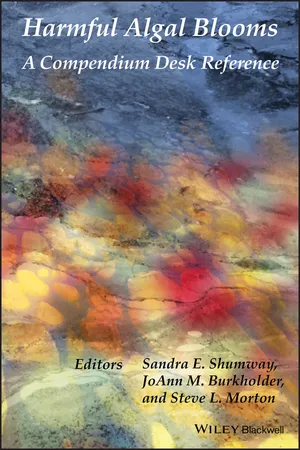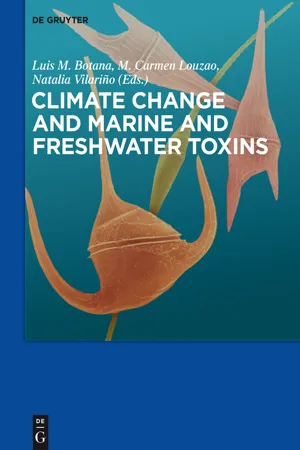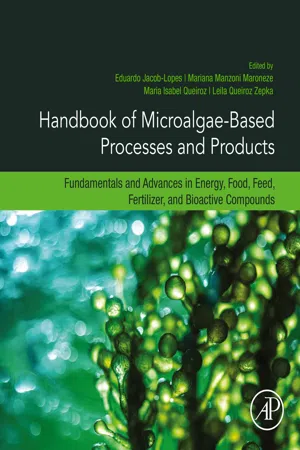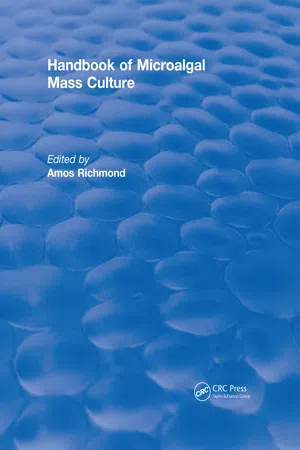Biological Sciences
Algal Blooms
Algal blooms are rapid increases in the population of algae in aquatic ecosystems. These blooms can be caused by factors such as nutrient pollution, warm temperatures, and calm water conditions. While some algal blooms are harmless, others can produce toxins that are harmful to humans and wildlife, leading to water quality issues and ecological imbalances.
Written by Perlego with AI-assistance
Related key terms
6 Key excerpts on "Algal Blooms"
- eBook - ePub
Handbook of Microalgal Culture
Applied Phycology and Biotechnology
- Amos Richmond, Qiang Hu(Authors)
- 2013(Publication Date)
- Wiley-Blackwell(Publisher)
The most immediate effect of eutrophication is the increased primary production by phytoplankton and other algae, for example, benthic and other aquatic plants. Primary production is a function of light, nutrient availability, and temperature and the net plant biomass depends on the cellular growth rate minus loss rates through dilution, sedimentation, grazing, and physiological death (Reynolds, 1984). While all factors either singly or in combination may be limiting, an increase in nutrients usually promotes an increase in plant biomass. A major outcome of eutrophication can be the proliferation of phytoplankton beyond their “normal” community balance. These proliferations or significant population increases are known as Algal Blooms (Smayda, 1997b).Algal Blooms may be detrimental to the functioning of the ecosystem per se , for example, by causing oxygen depletion and consequent death of fish and aquatic animals. As well, the mere physical presence of such densities of phytoplankton may cause damage to other organisms and they may produce exudates that damage the gill tissues of fish and thus are also detrimental to ecosystems (Horner et al., 1997). Blooms of algal species that produce toxins are the most damaging to ecosystems and can have profound food chain effects including human poisonings. Both toxic and other nuisance blooms are known as harmful Algal Blooms or HABs.The worldwide increase in eutrophication led Smayda (1989, 1997b) to propose a global epidemic of Algal Blooms. Early evidence to support this came from the correlation of increased population in Hong Kong from 1976 to 1986 with an increase in Algal Blooms or “red tides” in Tolo Harbour (Fig. 30.1 ). In the Baltic Sea, a site of extensive cyanobacterial blooms (Sellner, 1997), there was a doubling of primary production in the Kattegat between the late 1950s and early 1990s (Richardson & Heilmann, 1995). However, poisonings from HABs are known from historical times. Notable examples include the 1793 record on the US west coast of paralytic shellfish poisoning (PSP) and death of some of Captain George Vancouver's crew after eating mussels in Poison Cove, central British Columbia (Quayle, 1969), and the poisoning and death of cattle in Lake Alexandrina, South Australia, after drinking water from a bloom of the cyanobacterium Nodularia spumigena - eBook - ePub
Harmful Algal Blooms
A Compendium Desk Reference
- Sandra E. Shumway, JoAnn M. Burkholder, Steven L. Morton(Authors)
- 2018(Publication Date)
- Wiley-Blackwell(Publisher)
Figure 15.1 ); in addition, macroalgal HAB have become common in inland freshwater systems, including lakes, streams, rivers, springs, and reservoirs.Map showing the distribution of estuarine and coastal marine harmful macroAlgal Blooms (by phylum) in North America and Hawai'i, also including freshwater taxa along the Laurentian Great Lakes.Figure 15.1Here, harmful macroAlgal Blooms are operationally defined in both ecological and socioeconomic contexts, as in Burkholder (2009). Macroalgal HAB cause undesirable ecological changes in habitats and food webs or, in some cases, produce potent bioactive substances that adversely affect beneficial aquatic life. From a socioeconomic perspective, the excessive biomass also causes undesirable effects for humans, such as decreased recreational uses of beaches and waterways (due to rotting biomass, offensive odors, reduced water clarity, fish kills, and reduced waterfront real estate values, and through provision of habitat for microbial pathogens, mosquitoes, snails as vectors for schistosomiasis, and other noxious species); increased fouling of pumps, filters, and intake pipes; taste and odor problems in drinking water supplies; increased costs of water treatment; increased costs of managing aquatic resources; and, less commonly, direct toxicity to humans and other animals (wild and cultured fish, larvae of commercially important shellfish, waterfowl, livestock, and domestic pets). Socioeconomic impacts also include losses of commercially important finfish and shellfish due to habitat loss and fouling of fishing gear. - eBook - ePub
- Luis M. Botana, Carmen Louzao, Natalia Vilariño(Authors)
- 2015(Publication Date)
- De Gruyter(Publisher)
Gustaaf M.Hallegraeff 6 Harmful marine Algal Blooms and climate change: progress on a formidable predictive challenge 6.1 Introduction In a strict sense, harmful Algal Blooms are completely natural phenomena that have occurred throughout recorded history (e.g. Exodus, Captain Vancouver in 1793). Whereas in the past three decades unexpected new algal bloom phenomena have often been attributed to eutrophication [ 1 ] or ship ballast water introduction [ 2 ], increasingly novel algal bloom episodes are now circumstantially linked to climate change. It is unfortunate that so few long-term records exist of Algal Blooms at any single locality; ideally we need at least 30 consecutive years. Whether the apparent global increase in harmful Algal Blooms represents a real increase or not is therefore a question that we will probably not be able to answer conclusively for some time to come. There is no doubt that our growing interest in using coastal waters for aqua-culture is leading to a greater awareness of toxic algal species. People responsible for deciding quotas for pollutant loadings of coastal waters, or for managing agriculture and deforestation, should be made aware that one probable outcome of allowing polluting chemicals to seep into the environment will be an increase in harmful Algal Blooms. In countries that pride themselves on having disease and pollution-free aqua-culture, every effort should be made to quarantine sensitive aquaculture areas against the unintentional introduction of non-indigenous harmful algal species. Nor can any aquaculture industry afford not to monitor for an increasing number of harmful algal species in water and for an increasing number of algal toxins in seafood products, or to use increasingly sophisticated analytical techniques such as LC-MS - eBook - ePub
Handbook of Microalgae-Based Processes and Products
Fundamentals and Advances in Energy, Food, Feed, Fertilizer, and Bioactive Compounds
- Eduardo Jacob-Lopes, Mariana Manzoni Maroneze, Maria Isabel Queiroz, Leila Queiroz Zepka, Eduardo Jacob-Lopes, Mariana Manzoni Maroneze, Maria Isabel Queiroz, Leila Queiroz Zepka(Authors)
- 2020(Publication Date)
- Academic Press(Publisher)
Bankoff, 1999 ): Moses lifted his staff and struck the water in the Nile “and all the waters that were in the river were turned to blood. And the fish that was in the river died; and the river stank, and the Egyptians could not drink of the water of the river; and there was blood throughout all the land of Egypt” (Exodus 7: 20–21).Most oceanic Algal Blooms are harmless, but some cause significant disruption (Chisti, 2018 ). Harmful Algal Blooms are mostly caused by toxic dinoflagellate microalgae (Bankoff, 1999 ; Garcia Camacho et al., 2007 ) and affect aquatic life. Humans are affected usually by consumption of contaminated seafood (Chisti, 2018 ). Red tides as well as green blooms kill fish, birds, and sea animals; they cause human disease and death, and economic chaos (Chisti, 2018 ; Garcia Camacho et al., 2007 ). Algal Blooms are entirely natural, but have become more frequent in some regions, possibly because of nutrient discharges linked to human activity and inadvertent transport of algal cysts in ballast waters of ships (Bankoff, 1999 ; Chisti, 2018 ). The harmful algae are of course not entirely harmful, as they are potential sources of medicinal products (Chisti, 2018 ; Garcia Camacho et al., 2007 ; Sainis et al., 2010 ; Shimizu, 2000 ).1.9: Commercial production and processing of microalgal biomass
In addition to the microalgae biotechnology aspects mentioned in earlier parts of this chapter, numerous other aspects must be considered in developing microalgae-based production processes. Some of the fundamentals that need attention include the algal physiology and metabolism (Chapter 2 ) that influence production of a metabolite. The maintenance, preservation, and propagation of the algal strain require attention (Chapter 3 ), as the loss of a high-producer strain may jeopardize the viability of the entire commercial operation. New molecules and products may be designed for production in microalgae through synthetic biology approaches, as discussed in Chapter 4 . Once a large quantity of the biomass has been produced in either open ponds (Chapter 6 ; Chisti, 2012 ; Sompech et al., 2012 ; Terry and Raymond, 1985 ) or photobioreactors (Chapter 5 ; Chapter 6 ; Acién Fernández et al., 2013 ; Carvalho et al., 2006 ; Merchuk et al., 2007 ; Molina Grima et al., 1999 ; Sánchez Mirón et al., 1999 ; Tredici, 1999 ), it must be harvested, or separated from the water (Chapter 9 ; Chapter 10 ; Barros et al., 2015 ; Chatsungnoen and Chisti, 2019 ; Molina Grima et al., 2003 - eBook - ePub
- Amos Richmond(Author)
- 2017(Publication Date)
- CRC Press(Publisher)
Productivity of Algae Under Natural Conditions Zvy DubinskyAlgal Mass Culture and Water Blooms in Nature
The phenomena loosely christened “water blooms” have always attracted the attention of the practitioners of algal mass culture. The green, blue-green, reddish, and orange waters described from virtually any conceivable aquatic biotope, freshwater, marine, natural, or man-made, seemed to be the philosopher’s stone of applied algology. If only deciphered, the massive concentrations of microscopic algae occurring during blooms would be obtained by emulating the conditions which had led to the natural algal bloom, thereby creating a continuous algal crop to be harvested by man at will.This optimistic line of reasoning is in most cases unwarranted. The visible, occasionally noisome algal biomass represents in many instances a concentration in space and time of algal cells only slowly accumulated in a given locality or transported to it from vast expanses of water.1 , 2 and 3 In both such cases the true primary productivity per unit area and time may be low.Opposite extreme situations are also well known. Very high primary productivities of phytoplankton do not necessarily result in any noticeable buildup of algal populations either because of sinking of the algal cells out of the euphotic zone or because of extensive grazing by zooplankton, which consumes the increment of algal biomass.2 , 4 Another rather widespread phenomenon in tropical seas is the symbiotic association of dinoflagellates with invertebrate hosts such as corals.5 These dense populations of endozoic “captive phytoplankton” exhibit very high rates of photosynthesis; nevertheless, virtually all (>95%) of their photosynthate is translocated to the host leading to extremely low doubling rates of the algae.6Let us examine a few additional illustrative situations. In extremely hypertrophic aquatic ecosystems such as heavily polluted estuaries or oxidation lagoons with heavy organic loading, the water may become brilliant emerald-green due to extremely shallow, dense populations of flagellate algae such as Euglena and Chlamydomonas. These algae may form a film at the surface, only a few millimeters thick, because of the prevailing anaerobic conditions below the air-water interface and limited penetration of light. The depth integral of photosynthesis is inevitably low due to the extremely restricted euphotic zone. In cases where certain algal populations become buoyant because of formation of gas vacuoles, like in so many blue-green Algal Blooms,7 , 8 and 9 or in the case of the red-orange Botryococcus braunii blooms, due to lipid accumulation, we witness dense populations converging near the surface.10 These frequently moribund algae may create scums or almost solid “crusts” on the heavily polluted waters,1 as in Lake Erie or many fishponds11 on which water fowl may safely “walk on the water”. Again, in most such cases these blooms represent terminal phases of an algal population, rather than the expression of an energetically growing one (Figure 1 ). Primary productivities are low, losses due to excretion and lysis are high, and subsequent bloom cycles are initiated by resting cells resuspended from the sediment or residual populations that were not a part of the conspicuous bloom.12 - eBook - ePub
- Bernardo Duarte, Maria Isabel Violante Caçador(Authors)
- 2019(Publication Date)
- CRC Press(Publisher)
4 Effects of Harmful Algal Bloom Toxins on Marine OrganismsLopes, V.M.,1 ,2 ,* Costa, P.R.2 ,3and Rosa, R.11 MARE – Marine Environmental Sciences Centre, Laboratório Marítimo da Guia, Faculdade de Ciências da Universidade de Lisboa, Portugal.2 IPMA – Portuguese Institute for the Sea and Atmosphere, Avenida de Brasília, 1449-006 Lisboa, Portugal.3 CCMAR – University of Algarve, Campus of Gambelas, 8005-139 Faro, Portugal.* Corresponding author: [email protected]INTRODUCTION
Phytoplanktonic communities are vital to marine ecosystems. These communities constitute the basis of marine food webs throughout the planet, providing food for filter-feeding organisms, such as bivalves and planktivorous fish and also a number of vertebrate and invertebrate larval stages. Algal Blooms are natural occurrences, defined as the sudden overgrowth of microscopic algae under optimal environmental conditions, reaching up to millions of cells per litre (Hallegraeff 1993). These blooms are typically beneficial for the ecosystem, increasing feeding opportunities for countless organisms. However, if toxin-producing microalgae undergo this sudden overgrowth, it can lead to harmful Algal Blooms (HABs). Despite the fact that approximately 2 percent of microalgae species produce toxins (Hallegraeff 2014, Smayda 1997), HABs can significantly impact marine communities.In the marine realm, the majority of HAB-toxins are produced by dinoflagellates and diatoms (Table 1
Learn about this page
Index pages curate the most relevant extracts from our library of academic textbooks. They’ve been created using an in-house natural language model (NLM), each adding context and meaning to key research topics.





